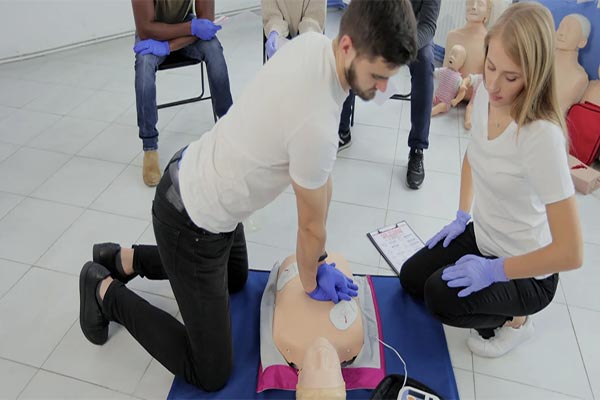
In today’s world, the importance of safety in schools cannot be overstated. From fire drills to active shooter protocols, educational institutions are constantly improving their safety measures to protect students and staff. One crucial aspect of school safety that often doesn’t get as much attention is CPR training for teachers. By equipping educators with the skills needed to perform CPR, schools can significantly enhance their overall safety protocols.
Cardiopulmonary resuscitation (CPR) is a life-saving technique used in emergencies when someone’s heartbeat or breathing has stopped. In a school setting, teachers are often the first responders to any incident involving a student or fellow staff member. Having CPR training empowers teachers to take immediate action in such emergencies, potentially saving lives before professional medical help arrives.

Beyond the physical skills, CPR training enhances the confidence of teachers. Knowing they can handle a medical emergency instills a sense of preparedness and calmness, which is crucial during high-stress situations. This confidence can be contagious, reassuring students and other staff members that they are in capable hands.
When teachers are trained in CPR, it fosters a culture of safety within the school. It sends a clear message that the institution prioritizes the well-being of its community. This culture encourages everyone, from students to administrators, to be more aware and proactive about safety measures.
In medical emergencies, time is of the essence. The quicker CPR is administered, the higher the chances of survival. By having trained teachers on-site, the response time to a cardiac event or similar emergency is drastically reduced, which can be the difference between life and death.
For schools looking to implement CPR training, partnering with certified organizations is a crucial first step. These organizations provide comprehensive training programs tailored to school environments. Programs typically cover basic CPR techniques, use of automated external defibrillators (AEDs), and how to manage choking incidents.
CPR skills can diminish over time if not practiced regularly. Schools should schedule periodic refresher courses to ensure that teachers’ skills remain sharp and up-to-date. These sessions also provide an opportunity to update staff on any new CPR guidelines or techniques.
While the primary focus is on training teachers, schools should also consider offering CPR training to older students. This empowers students to take responsibility for their safety and that of their peers. Student participation in CPR training can further embed the culture of safety within the school.

One of the main challenges schools face is finding the time for training without disrupting the academic schedule. Solutions include integrating CPR training into professional development days or after-school programs, ensuring that it doesn’t interfere with regular teaching hours.
Budget constraints can also be a hurdle. However, many organizations offer affordable training packages for schools, and some local health departments provide grants or funding assistance. Investing in CPR training is a long-term benefit that outweighs the initial costs.
CPR training for teachers is not just a beneficial skill; it is a vital component of comprehensive school safety strategies. By equipping educators with the knowledge and confidence to respond to medical emergencies, schools create a safer environment for everyone. Encouraging a culture of safety and preparedness leads to quicker response times and can ultimately save lives. As schools continue to evolve their safety protocols, CPR training should remain a top priority.
Incorporating CPR training into the school curriculum is a proactive step toward ensuring the safety and well-being of students and staff alike. By doing so, schools can effectively enhance their overall safety measures, providing peace of mind to parents, students, and educators.
Getting CPR certified can make a significant difference in your ability to respond during critical emergencies. We encourage educators and individuals alike to take this proactive step by enrolling in a CPR certification course. CPR Classes Near Me offers comprehensive training programs that are convenient and tailored to your needs. By gaining the skills and confidence that CPR training provides, you become an essential part of a safer community. Visit our website to find a class near you and take the first step toward making a life-saving impact.
Our primary goal is to ensure that you receive a top-quality CPR/First Aid certification. With our in-person training in Austin, you can learn CPR and BLS in just one class. Your presence is all that’s needed to continue with your lesson! During your session, you will complete all the live-training components necessary to ensure you receive your AHA Healthcare Provider certification card.
Our CPR Classes in Austin are discounted to $59.95 (saving you $20), and our CPR + First Aid Class is offered at $79.95 (also saving you $20). When looking for CPR Classes, ensure to check for the American Heart Association seal. Other sites might seem cheaper but frequently lack the official training credentials demanded by employers.
Upon successful completion of the course, you will obtain a CPR certification that is valid for two years. The AHA CPR certification is recognized with the highest acceptance rate among employers nationwide.
Indeed! Enroll in any CPR Certification Austin BLS course to extend your certification for an additional two years. The in-person BLS course and the Renewal Class are identical.
Anyone capable of completing the course independently should consider pursuing CPR training and CPR Certification. There is no minimum age restriction for obtaining a CPR certification in Austin through the American Heart Association (AHA)..
CPR training needs to be carried out in person to guarantee its effectiveness. Our experienced instructors offer an engaging and dynamic learning experience. Typically, employers do not recognize CPR certifications that are obtained solely through online courses.
All authorized American Heart Association training centers are obligated to display the entire video. After a three-hour session with CPR Classes Near Me Austin, your BLS CPR eCard will be promptly issued by the instructor on the same day!